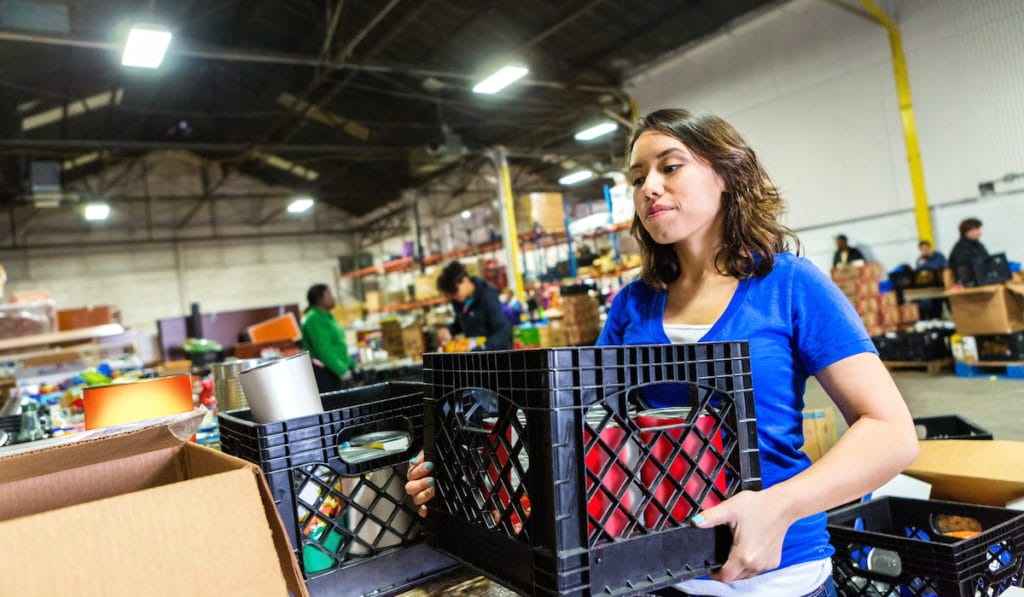
With increased jobless levels ever since the 2020 coronavirus pandemic, a growing number of Americans have been turning to federal food assistance programs. These programs offer an opportunity to stretch limited dollars. Yet for families managing food allergies, they can result in frustration and potentially unsafe food choices.
Funded by the U.S. Department of Agriculture, and administered by states, the assistance programs have policies to protect people with food allergies. But experts are concerned that some of the most high-profile subsidy programs offer limited food options and quality. They also don’t account for the higher costs of allergy-friendly foods, and make it difficult to enforce laws designed to protect the rights of people with food allergy.
The following food programs are among the most widely used – and predicted to grow throughout the coronavirus pandemic.
Supplemental Nutrition Assistance Program (SNAP)
SNAP is the
largest federal nutrition assistance program. It provides benefits to eligible
low-income individuals and families via an electronic benefits transfer card
that’s used like a debit card to make purchases at the grocery store. Eligible
foods include fruits and
vegetables; meat, poultry, and fish; dairy products; breads and cereals; snacks
and non-alcoholic beverages; and seeds and plants that provide household food. Benefits
are calculated based on factors including household size, but do not take into
consideration the differences in food costs.
For families managing food allergy those can be considerable. A
2013 study
led Chicago’s Lurie Children’s Hospital and Northwestern University found that,
compared to other U.S. households, these families pay an additional $4,184 per
year. Overall, out of pocket costs were $5.5 billion annually,
with 31 percent stemming from the cost of special foods.
“The challenge for food allergy families is you don’t get any extra SNAP dollars because you have food allergy [and you] pay more for your food,” says Emily Brown, founder of the nonprofit Food Equality Initiative. FEI works to increase access to allergy-friendly and gluten-free foods through its national advocacy work and direct food distribution in the Kansas City area. The upshot, she says, is “the benefit doesn’t go as far as it would for a family that didn’t have these medical needs.”
There are also data to suggest that families who utilize SNAP benefits are more likely to experience food-induced anaphylaxis than the general food-allergic population, which may be due to the lack of resources available to purchase allergy-friendly foods.
Women, Infants, and Children (WIC)
WIC is a federal nutrition assistance program for pregnant, postpartum and breastfeeding women, infants and children up to age 5. To qualify, you need to meet income guidelines and a health professional needs to confirm there’s a “nutritional risk” due to a medical or dietary condition. This can include food allergy.
Participants receive vouchers for food. WIC foods include: infant cereal, iron-fortified adult cereal, fruit or vegetable juice, eggs, milk, cheese, peanut butter, dried and canned beans/peas, and canned fish. Soy-based beverages, tofu, fruits and vegetables, baby foods, whole-wheat bread, and other whole-grain options were recently added. The list is dominated by nearly all of eight most common food allergens, which can create limitations for those trying to avoid unsafe foods.
Emily Brown | Black Families in Food Allergy Need to be Heard
See all available Talking Food Allergy podcasts
The Emergency Food Assistance Program (TEFAP)
TEFAP helps supplement the diets of low-income Americans, including elderly people, by providing them with emergency food assistance at no cost. Through TEFAP, the USDA purchases a “variety of nutritious, high-quality USDA Foods,” and distributes through state agencies. States then provide the food to local agencies that they have selected, usually food banks, which in turn distribute to food pantries that directly serve the public.
The recently passed Families First Coronavirus Response Act increased funding for the federal government to purchase surplus commodities for distribution in TEFAP. Although this increases access, researchers note that the program still “lacks procurement policies to ensure a minimum percentage of commodities are free of the top allergens.”
Child Nutrition Programs
A set of programs provide “healthy, nutritious meals and snacks” to American children through the National School Lunch Program and School Breakfast Program, the Child and Adult Care Food Program, and the Summer Food Service Program.
After Coronavirus-related school closures, school districts continued to offer free meals to eligible children through on site pick up. Typically, children must live in a low-income area, but waivers were issued by the USDA to states that allow schools to distribute food to children with far fewer restrictions. That includes which foods are served to participants.
Emily Brown recalls that although she had previous contact with her local lunch pick-up site, when her husband arrived, he was given peanut butter and jelly sandwiches for their daughters – despite federal 504 Plans documenting their peanut allergies.
“During the school year, when school provides meal modifications (for food allergies), it gets a higher reimbursement,” says Brown, who is the founder and CEO of Food Equality Initiative. “But with waivers, and during the summer meal programs, they don’t. There is no incentive (for them) to make accommodations. If you can’t eat what’s on it, you’re out of luck.” Brown informed the head of school nutrition, and the site did improve their protocols.
A 2019 study found that child nutrition program menu planners perceive providing allergy-safe foods to be costlier than non-modified menus because of: the additional costs of special foods, increased labor to purchase these foods, planning menus, training food-service workers, communication with nutrition staff, separation of food production areas to avoid cross-contact, and time for documentation. This raises concerns about whether compromises may get made to offset these increases in food and labor costs.
Recourse for Food Allergy Families
One of the challenges faced by food allergy families who qualify for the school lunch program and others is that an “appropriate substitute” for a nutritional meal varies vastly from district to district, state to state, says Brown.
So, what rights do people with food allergies have under these programs if accommodations are not followed? The USDA states that its programs must comply with federal laws that outlaw discrimination against people with disabilities, such as the Americans with Disabilities Act, Section 504 of the Rehabilitation Act of 1973, and the Individuals with Disabilities Education Act.
For instance, under the National School Lunch Program, a child with food allergies cannot be served foods containing their allergens, and lunch providers must check food labels for allergens of products served to children with food allergies. The allergen-safe meal has to be the nutritional equal of the regularly served meal.
“Schools, entities and other programs that receive federal funding must provide full and equal access,” says disability rights attorney Mary Vargas of the Washington, D.C.-based firm Stein & Vargas. “This means that people with food allergies must receive the same quality and selection of food as people without.”
This also means that other protections that are in place, such as a 504 or Individual Health Plan, must be honored.
The problem is what happens when an entity doesn’t meet its obligation. Vargas explains that many people don’t know they have a right to allergy-safe foods under these programs. When programs don’t provide this, the onus remains with the family to require a program to follow the law, by filing a grievance.
But “by definition, people with food insecurity and financial insecurity don’t have the bandwidth, the time to pursue these grievances, nor do they want to rock the boat to assert their right to challenge a program that they need,” she says.
Brown notes that most of these nutrition programs don’t have food allergies in the forefront of planning. “It’s shocking that in 2020, food allergy, an emerging public health epidemic is an afterthought when we design programming to provide food.”
Jen Jobrack is the host of Allergic Living’s Talking Food Allergy Podcast.
Related Resources
Food Allergy and Asthma: the Burden on Black Community
Food Allergies at School: Know Your Child’s Rights
New York’s Elijah’s Law Requires Allergy Protocols in Preschool
7 Mistakes to Avoid at a 504 Plan Meeting






